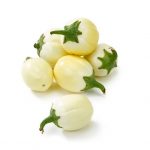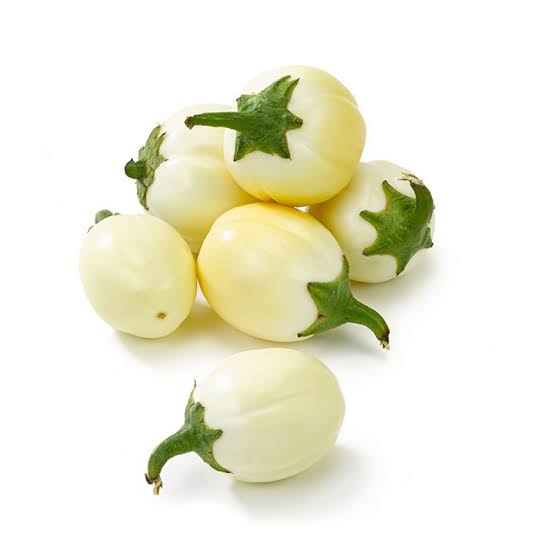Solanum macrocarpon L. (synonym: Solanum dasyphyllum Schumach. & Thonn.) or Gboma, Garden egg, Gboma eggplant, African eggplant, Scarlet Eggplant, Tomato-fruited eggplant (English) or Gautan kaji (Hausa) or Afufa, Mkpuruofeor (Igbo) or Bamomi, Igbagba (Yoruba): A shrub with potential to improve nutritional status of citizens of developing countries.
ORIGIN/OCCURRENCE OF AFRICAN EGGPLANT (GARDEN EGG)
The genus Solanum comprises over 1000 species worldwide. In Africa and adjacent islands it is represented by at least 100 indigenous species; about 20 of these are recent introductions. Solanum macrocarpon has an African ancestry. Spiny wild forms are found throughout the tropical non-arid parts of Africa, their fruits still being gathered occasionally as vegetable, whereas the cultivated forms, called ‘gboma’ in West Africa, constitute an important fruit and leaf vegetable, grown for the market and in home gardens. Local cultivars grown for the leaves are common throughout West and Central Africa, while the fruit types are mainly restricted to the humid coastal areas of West Africa. Gboma has been recorded in many West African countries and probably occurs in all coastal countries. It is also widespread in Central and East Africa. In southern Africa it has been recorded as a vegetable in Malawi, Zambia, Zimbabwe and Mozambique. Several fruit cultivars can also be found in South America (Suriname) and the Caribbean, apparently introduced from West Africa, the local name in Suriname being ‘ndrowa’ (’ndrowa’ is the name of certain types of Solanum aethiopicum L. in Côte d’Ivoire). It has been reported from Thailand and Indonesia, but this is probably erroneous and concerns a different species.
IMPORTANCE/HEALTH BENEFITS OF AFRICAN EGGPLANT
The young leaves and young fruits are cooked and consumed as a vegetable. The leaves are eaten as a separate dish or in sauces together with other ingredients. The taste is more or less bitter and very much liked. The leaves can either be steamed (as practised in Uganda) or fried in oil with onions.
In West Africa, both leaves and fruits are eaten. A popular cultivar in Benin is a small-fruited leaf type, whereas in Côte d’Ivoire a big-fruited type grown for its fruits is popular. In Uganda, it is mostly the leaves that are eaten, but the fruits are added to sauces.
The composition of Gautan kaji leaves is comparable to that of other dark green leaf vegetables, while the composition of Gautan kaji fruits is similar to that of eggplant (Solanum melongena L.). Gautan kaji leaves contain per 100 g edible portion: water 85.6 g, energy 42 kcal, protein 4.6 g, fat 1.0 g, carbohydrate 6.4 g, fibre 1.6 g, Ca 391 mg, P 49 mg. Gautan kaji fruits contain per edible portion of 100 g: water 89.0 g, energy 40 kcal, protein 1.4 g, fat 1.0 g, carbohydrate 8.0 g, fibre 1.5 g, Ca 13 mg. As can be seen the leaves of the Gautan kaji are nutritionally richer in nutrients that the fruits.

Generally, eggplant is a good source of minerals and vitamins (particularly iron) making its total nutritional value comparable with tomato. It is an inexpensive but major food component of the human diet in the developing world most particularly in India and China. The leaves, fruits and roots have a variety of medicinal uses. In Sierra Leone, heated leaves are chewed to treat throat troubles; in Nigeria fruits, are taken as a laxative, and to treat cardiac diseases, while flowers and fruits are chewed to clean the teeth. In Kenya, the juice of boiled roots is drunk to get rid of hookworms, while crushed leaves are taken to treat stomach troubles. Solanum macrocarpon is occasionally grown as an ornamental.
FUTURE
Gboma with its slightly bitter taste is liked by consumers. The high nutritive value of the leaves and the high leaf and fruit yield, as well as the fairly high resistance to pests and diseases make the crop interesting for development.
The leafy cultivars have potential for introduction in semi-arid areas to improve the nutritional status of the population. The fruity cultivars have potential for promotion in hot humid areas. The considerable variation within the species gives it high potential for breeding for various purposes. Development of the export market will require uniform cultivars and putting in place a good system of post-harvest handling.
MAJOR REFERENCES: African indigenous vegetables. An overview of the cultivated species. Natural Resources Institute/ACP-EU Technical Centre for Agricultural and Rural Cooperation, Chatham, United Kingdom; A review of the genus Solanum in Africa. In: D’Arcy, W.G. (Editor). Solanaceae: biology and systematics. Columbia University Press, New York, United States.
These are the thoughts of:
Sa’eed Halilu Bawa
Senior Lecturer (Associate Professor) at University of the West Indies, St. Augustine Campus, Trinidad.
Studied Food and Nutrition Sciences, Dietetics at Kaduna Polytechnic, Nigeria; Warsaw University of Life Sciences, Poland.
























